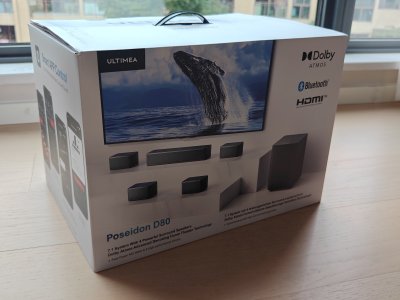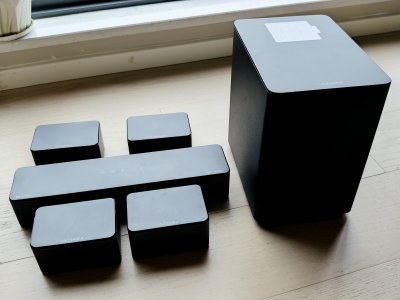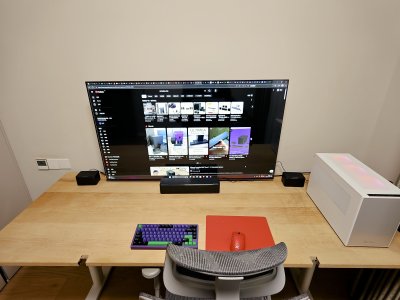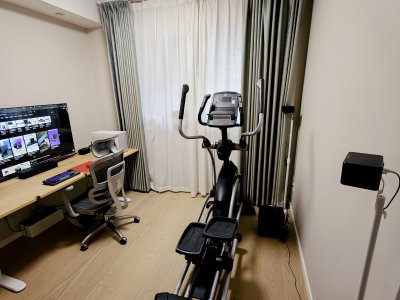hema384578
New member
Hello everyone, although ULTIMEA is a Chinese company, because they focus on overseas markets, obtaining their products in China isn't easy. I managed to get my hands on this ULTIMEA D80 through certain channels and have been using it for almost a month. Now I'd like to share my impressions and suggestions:
1. Undoubtedly, the outer packaging is typical of Chinese e-commerce – simple, reliable, but slightly monotonous. I personally think the purple packaging for the later D80 DOOM is more vibrant.
2. The build quality is good. Although it's made of plastic, you can't expect too much at this price point.
3. Unlike most people, I use the D80 as a desktop multi-channel speaker system, replacing my long-serving Creative GigaWorks THX S750. As an aside, back in the day, this Creative speaker system, along with the Logitech Z-680, wasn't just a top-of-the-line desktop multi-channel speaker system, but also the first choice for many entry-level home theaters. Unfortunately, due to the lack of HDMI and Dolby Atmos support, desktop multi-channel systems gradually disappeared from the market.
4. My impressions of the D80: Perhaps because it uses full-range speakers, the D80's high frequencies aren't particularly outstanding. However, its midrange performance in games and online videos is good. In immersive movies, the D80 creates a great atmosphere, providing a good cinematic experience in my 15-square-meter room. However, the sound directionality of the rear speakers is not very pronounced; I'm not sure if it's due to my speaker placement. The later D80 BOOM added the X-Upmix function, which theoretically should enhance the surround sound directionality. Unfortunately, I can't buy the D80 BOOM in China, so I can't compare the differences between the old and new D80s.
Finally, my suggestion: Add an EQ import function to the app, allowing users to import pre-set EQ curves, such as Harman curves, to enhance the speakers' musicality.
At least the high-end Ultimea models' app offer space testing and tuning functions, as room acoustics vary, similar to the Dirac function on high-end AV receivers (my current Integra DRX-5.4 has this built-in function, which greatly improves sound quality in rooms without acoustic treatment).
It provides decoding capabilities for DTX and other audio tracks without significantly increasing costs, and includes a desktop stand for compatibility with desktop environments.
Later, I will test the potential and improvement directions of the Ultimea D80 by changing the front surround speakers, giving all Ultimea D80 users more ways to use it.






1. Undoubtedly, the outer packaging is typical of Chinese e-commerce – simple, reliable, but slightly monotonous. I personally think the purple packaging for the later D80 DOOM is more vibrant.
2. The build quality is good. Although it's made of plastic, you can't expect too much at this price point.
3. Unlike most people, I use the D80 as a desktop multi-channel speaker system, replacing my long-serving Creative GigaWorks THX S750. As an aside, back in the day, this Creative speaker system, along with the Logitech Z-680, wasn't just a top-of-the-line desktop multi-channel speaker system, but also the first choice for many entry-level home theaters. Unfortunately, due to the lack of HDMI and Dolby Atmos support, desktop multi-channel systems gradually disappeared from the market.
4. My impressions of the D80: Perhaps because it uses full-range speakers, the D80's high frequencies aren't particularly outstanding. However, its midrange performance in games and online videos is good. In immersive movies, the D80 creates a great atmosphere, providing a good cinematic experience in my 15-square-meter room. However, the sound directionality of the rear speakers is not very pronounced; I'm not sure if it's due to my speaker placement. The later D80 BOOM added the X-Upmix function, which theoretically should enhance the surround sound directionality. Unfortunately, I can't buy the D80 BOOM in China, so I can't compare the differences between the old and new D80s.
Finally, my suggestion: Add an EQ import function to the app, allowing users to import pre-set EQ curves, such as Harman curves, to enhance the speakers' musicality.
At least the high-end Ultimea models' app offer space testing and tuning functions, as room acoustics vary, similar to the Dirac function on high-end AV receivers (my current Integra DRX-5.4 has this built-in function, which greatly improves sound quality in rooms without acoustic treatment).
It provides decoding capabilities for DTX and other audio tracks without significantly increasing costs, and includes a desktop stand for compatibility with desktop environments.
Later, I will test the potential and improvement directions of the Ultimea D80 by changing the front surround speakers, giving all Ultimea D80 users more ways to use it.







